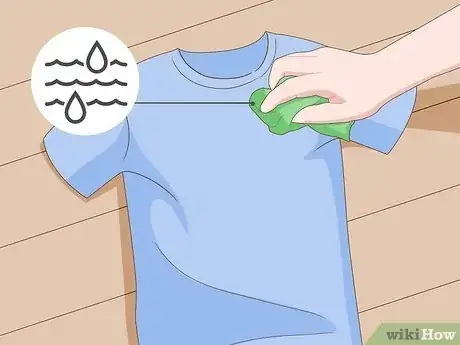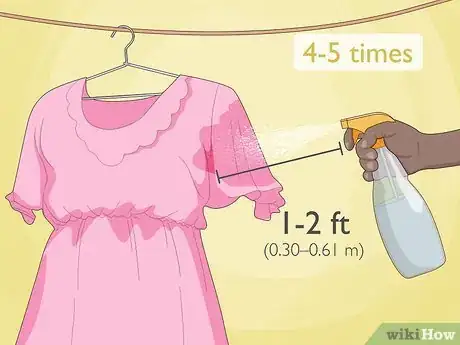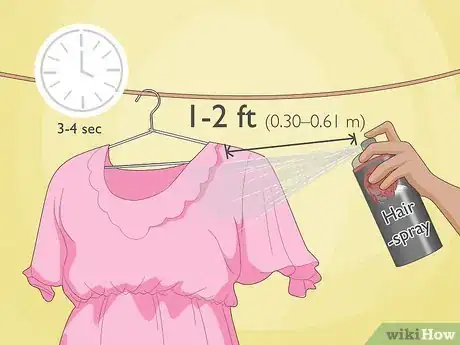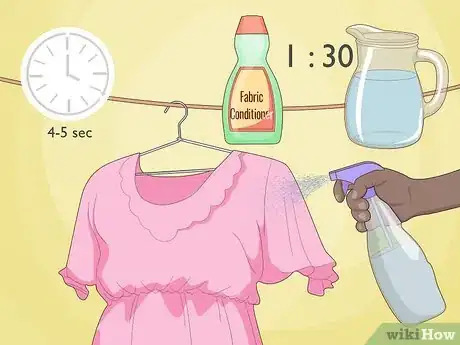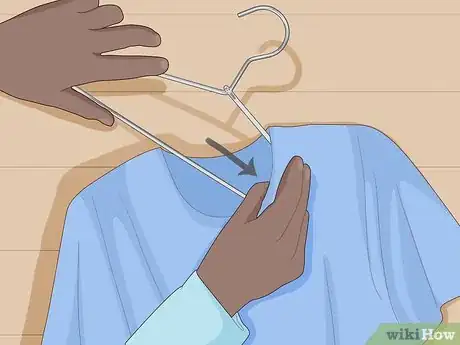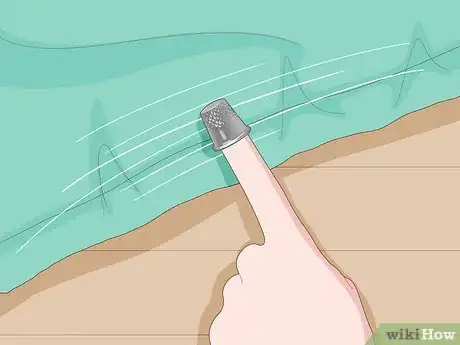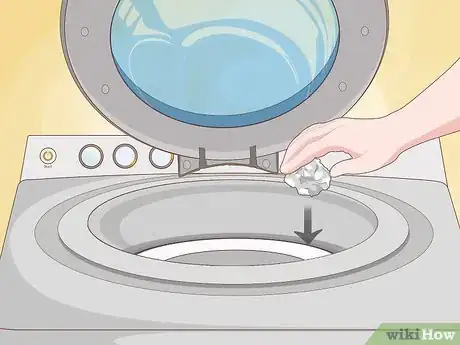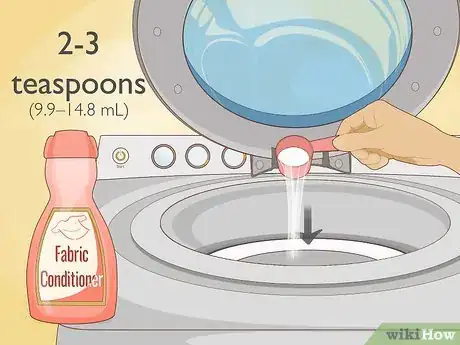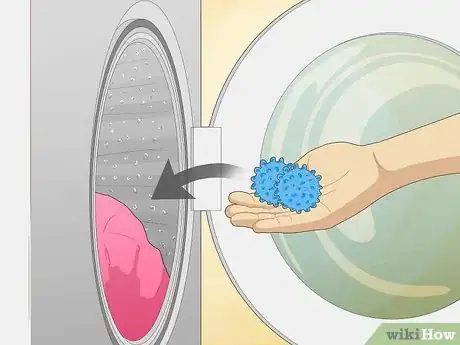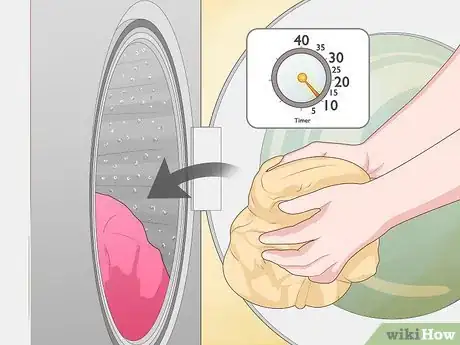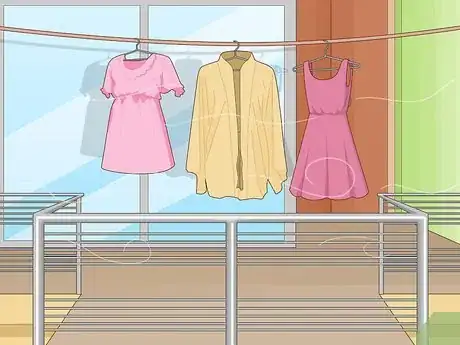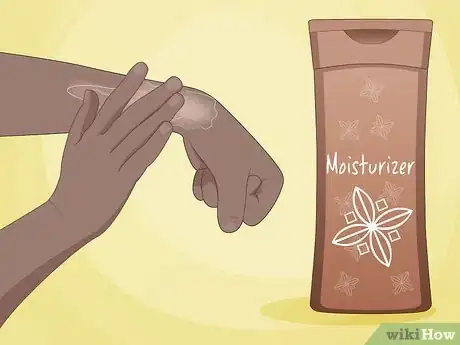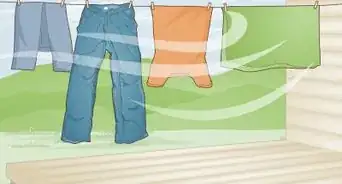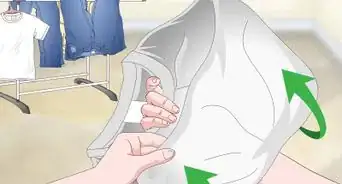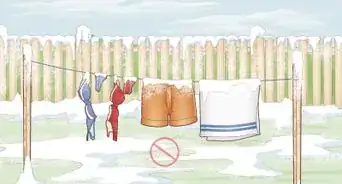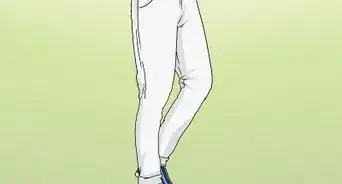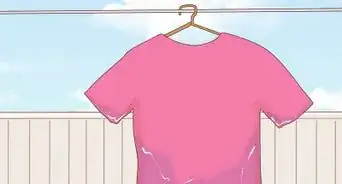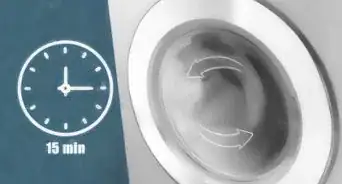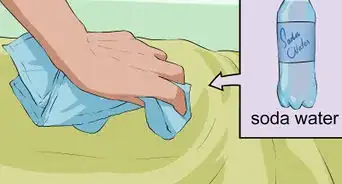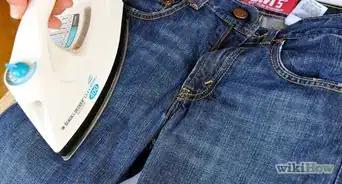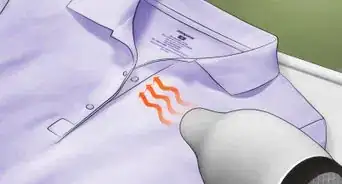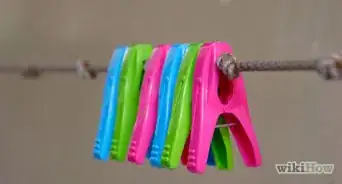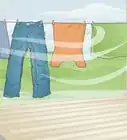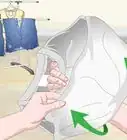This article was co-authored by Kamel Almani and by wikiHow staff writer, Eric McClure. Kamel Almani is a Laundry and Cleaning Specialist and the Co-Owner of WashyWash, a toxin-free and eco-friendly laundry and dry clean service based in Amman, Jordan. Kamel and his staff at WashyWash use Blue Angel certified and dermatologically-tested detergents. They also combine EcoClean and digital technology to provide an eco-friendly, convenient, and quality cleaning service. Kamel holds a BA in Design from the University of Applied Science, Amman.
There are 10 references cited in this article, which can be found at the bottom of the page.
wikiHow marks an article as reader-approved once it receives enough positive feedback. This article has 22 testimonials from our readers, earning it our reader-approved status.
This article has been viewed 1,811,470 times.
We all know that uncomfortable feeling of clingy fabric and the familiar crackle of static when you pull on a nice sweater or your favorite shirt. Static cling is caused by electrical charges that build up in your clothes due to dryness and friction. Fortunately, whether you’re at home or on the go, static is easy to get rid of with the help of a few common items like a damp cloth, coat hanger, or dryer sheet! Keep reading for our complete guide to quickly removing static cling from clothes—we’ll even give you laundry hacks to help eliminate static for good.
Things You Should Know
- To quickly and easily remove static cling, try rubbing a damp cloth or dryer sheet over your clothes, or putting some moisturizer on your skin.
- You can also run a metal object, like a metal hanger or safety pin over the fabric to discharge the electricity.
- If static is an everyday problem, change up your laundry routine by adding a bit of fabric conditioner or baking soda to the wash, or by adding a damp washcloth to the last 10 minutes of the drying cycle.
Steps
Quick Fixes
-
1Rub your clothes with a dryer sheet or damp cloth. This is a great option if you’re in a hurry or already wearing your clothes. The coating on dryer sheets is positively charged, so it’ll help to balance out the buildup of negative electrons that can cause static.[1] Similarly, the damp cloth will help prevent the static buildup because water is a good conductor that’ll give the electrons a path to go.[2]
- You can re-use the same dryer sheet several times.
-
2Mist your dried clothes lightly with water. Fill an empty spray bottle with lukewarm tap water. Stand away from your clothing and spritz it 4-5 times while standing 1–2 ft (0.30–0.61 m). Spray enough water to mist your clothing without soaking it or making it damp. The water will neutralize the static charges that cause cling to occur.[3]
- Do this right before you put your clothing item on for the best results.
Advertisement -
3Spritz your clothes with hairspray to remove static. Grab any can of hairspray. Stand 1–2 ft (0.30–0.61 m) away from your clothing and spray it with the hairspray for 3-4 seconds. This will lightly cover the clothing in the hairspray without soaking it. Hairspray is specially formulated to combat static in your hair, but the same chemicals will prevent static cling from occurring on your clothes.[4]
- Do this immediately before you wear your clothes so that the hairspray doesn’t have time to wear off or dissipate.
- Hairspray won’t normally stain your fabric, but it may leave a residue behind. If you’re worried about staining or damaging your clothing item, turn it inside-out before spraying the hair product on to your clothes.
Tip: The hairspray should be sprayed from a distance to prevent it from leaving visible traces on your clothing. For best results, focus your efforts on the areas of clothing that stick to you the most.
-
4Spray a fabric conditioner on your clothes to minimize cling. Mix 1-part of liquid fabric softener with 30-parts water and fill an empty spray bottle with the ingredients. Shake the bottle to mix the ingredients together. Stand 1–2 ft (0.30–0.61 m) away from your clothing and mist your clothing for 4-5 seconds. This will minimize the effect of static cling on your clothing. Do this right before you’re going to put your clothes on for the best results.[5]
- Most fabric softeners won’t stain your clothing, especially when it is diluted with water. If you’re worried about staining your clothes, turn the clothing inside-out before spritzing it.
- Stain removers and wrinkle removers will usually work just as well.
Using Metal to Remove Static
-
1Slide the affected clothes through a metal hanger. After you’ve washed and dried your clothes, grab a metal or wire clothing hanger. Before you put your clothes on, gently glide the metal hanger over your clothes. The metal discharges the electricity and removes the static. When you go to hang your clothing, hang clothing that is sticking and clinging with a metal hanger.[6]
- You can also pass a metal hanger in between your skin and your clothes after putting the clothes on.
- This works particularly well with delicate fabrics, like silk. However, metal wire hangers can distort some clothing items, like heavy sweaters. If you think that your clothing may be damaged by a wire hanger, simply run the hanger over the surface of the fabric before storing your item some other way.
-
2Hide a safety pin inside of your clothes to absorb static. Take a metal safety pin and turn your clothing inside out. Unlock the pin and slide it through the seam of your clothing so that it’s hidden from the outside. Turn your clothing out to face the right direction and put your clothing on. The safety pin will absorb any static electricity.[7]
- It doesn’t matter if you’re removing your clothes from the dryer, closet, or dresser. The pin will still work to remove static cling.
- Avoid placing the pin on the front or near an exposed hem, since others will be able to see it if you do.
-
3Run a metal thimble or brush over the fabric. Running a metal object across your clothing discharges the static electricity. After drying your clothes, put a metal thimble on your finger. Run the finger across the surface of every clothing item to reduce the static charge. You can use a metal-bristled brush instead of a thimble if you prefer, although this may not be the best choice if your fabric could snag on the bristles.[8]
- As with other tricks involving metal, the idea is to discharge the electrical charge to prevent static. Touching any metal object will accomplish the same goal if you do not have a metal thimble.
Tip: If you don't want to walk around with a thimble on your thumb, you can tuck it away in your pocket and pull it out only as necessary. This may also help to reduce the amount of static building up in your clothes as you walk around.
Laundry Tips
-
1Add 1⁄2 c (120 mL) of baking soda to your wash cycle. Baking soda will function the same way as fabric conditioner to absorb the electrical charges as your clothes wash. Before you start your wash cycle, pour 1⁄2 c (120 mL) of baking soda into the drum of the washer. Add your standard detergent and wash your clothes as you normally do.[9]
- If you plan on machine drying your clothes, some of the charge may come back after the baking soda has been washed out. This method works best when used in conjunction with another way of removing static. You may not need to use another method if you air dry your clothes instead of machine-drying them, though.
- For smaller loads with less than 3–4 lb (1.4–1.8 kg) of clothing, feel free to decrease the amount of baking soda to 1⁄4 c (59 mL).
- Baking soda effectively creates a barrier around each garment, preventing negative and positive charges from building up and causing the garments to stick together.
- Baking soda has the added benefit of neutralizing odors.
-
2Sprinkle 1⁄2 c (120 mL) of white vinegar into your rinse cycle. After the washing machine completes its initial wash cycle, pause the machine and pour 1⁄2 c (120 mL) of distilled white vinegar over your clothes. Restart the machine and allow it to continue its rinse cycle. Vinegar softens fabrics, preventing them from becoming too stiff and dry. This also helps to reduce the amount of static build-up.[10]
- Do not use vinegar with bleach. These ingredients produce a noxious gas when they’re combined. Do not use this method with the baking soda, although it’s fine if you want to use tinfoil and fabric softener.
- If you don’t want your clothes to smell like white vinegar, soak a washcloth in the vinegar instead and add that to the rinse cycle. The odor shouldn’t be too overwhelming, even if you add the vinegar straight to the rinse water.
- If you have a softener dispenser in your machine, you can pour the vinegar inside at the start of the entire cycle. Adding vinegar to your clothing also results in brighter colors and cleaner whites.
- White vinegar works best, but in a pinch, you can use apple cider vinegar. You may not want to use apple cider vinegar on white or lightly-colored clothing, though.
-
3Throw a ball of tinfoil into the washing machine with your clothes. Take a sheet of tinfoil and crumple it up into a small ball. Pack it tightly by squeezing it between both of your hands over and over. Add your ball of tinfoil to your washer and run your normal cycle. The tinfoil discharges positive and negative charges that the washing machine produces.[11]
- You can use tinfoil along with any other method, although you should avoid mixing baking soda and vinegar in your washing machine.
Warning: Only add your tinfoil to the washing machine. Do not add it to the dryer. If you dry the tinfoil, it could create a fire. Be sure to remove the tinfoil ball when moving your clothes from the washer to the dryer.
-
4Use fabric softener to prevent charges from building up. Liquid fabric softener helps prevent static from building up during the wash cycle. Add 2–3 teaspoons (9.9–14.8 mL) of liquid softener to your standard cycle per your softener’s instructions. As wet clothes are tossed around in the washer, they build up an electrical charge that causes them to stick together. Fabric softeners contain chemicals designed to stop that electricity from building.[12] [13]
- Softener sheets work the same way as fabric softener. Get sheets if you want to avoid messy liquids. Softener sheets are typically added to the dryer, though.
- You can use fabric softener alongside any other method in this section.
Dryer Tips
-
1Add a dryer ball to your dryer before adding your wet clothes. Dryer balls will work the exact same way as the sheets or fabric softener. They are designed to soften clothes without the use of chemicals. Add 1-2 dryer balls to your machine when you transfer your wet clothes to the dryer and run your dryer cycle as you normally do.[14]
- Dryer balls also minimize the amount of contact fabrics have with one another in the machine. Electrical charges build up in fabric as one piece rubs up against another, so minimizing this contact also minimizes static.
-
2Add a damp washcloth to the last 10 minutes of the drying cycle. When your drying cycle has 10 minutes remaining, pause it. Switch the dryer to the lowest heat setting and throw a clean, damp washcloth into the machine. Turn the cycle back on and finish it. The water will absorb some of the electrical charges from the dryer and encourage clothes to remain soft and cling-free.[15]
- This is essentially the same thing as misting your clothes with water after they dry.
-
3Shake your clothes when removing them from the dryer. As you remove each item of clothing from your dryer, give them 2-3 quick shakes. This prevents static from setting in as your clothes are placed on another surface.
- This only works if you take your clothes out immediately after they’ve finished drying.
-
4Air dry your clothes to avoid static altogether. Instead of running your clothes through the machine, dry them by hanging them on a clothesline or closet rod. Take each item out of the machine after it has finished washing and hang it on the line or rod with a hanger or clothespins. Alternatively, you can run the dryer through half of a cycle to partially dry your clothes and then air dry them for the remainder of the time.[16] [17]
- A good portion of the electrical build-up responsible for static cling occurs when wet clothes are completely dried out using heat. Air drying prevents clothing from becoming extremely dry, which also prevents it from developing too much of an electrical charge.
- For an added layer of cling removal, hang your clothes on metal hangers to air dry them.
Preventing Static Cling
-
1Moisturize your skin to keep clothes from sticking. Any kind of moisturizing lotion will work to remove static cling. Before putting your clothes on, rub moisturizer into your legs, torso, and arms. Work it into your skin until there are no visible globs of lotion remaining. Moisturizer will dispel static as your clothes absorb it from your skin.[18]
- By moisturizing your skin, you remove dryness that would otherwise attract a highly-charged fabric.
- You can rub lotion over your hands before removing laundry from the dryer or folding your clothes. This will prevent excess electrical charge from transferring from your hands to the fabric.
Tip: If you don’t want to add a ton of lotion to your skin, rub a small amount on your hands and lightly run them around your body to add a small amount of moisture.
-
2Use a moisturizing conditioner to maintain your hairstyle. If static cling from your clothing is causing your hair to become frizzy, get a moisturizing conditioner or hair product. When you shower, rub the conditioner through your hair after shampooing. If you’re using a moisturizing hair product, dry your hair and work the product through each section of your hair before styling it.[19]
- Silicone-based conditioners will help keep static away from your hair more effectively, but there’s a lot of debate over whether silicone is good for your hair or not.
- Moisturizing your hair will keep your hair from drying out. Dry hair is prone to attracting static electricity, which is what causes static cling.
-
3Swap your rubber-soled shoes out for a leather pair. Most shoes have rubber soles. This presents a problem with static though, since static charges can build up in rubber. If you find your clothes developing static cling throughout the day, swap your shoes out for a pair of leather-soled shoes.[20]
- Wearing leather shoes will help you stay grounded since leather does not build up electrical charge as easily as rubber.
Community Q&A
-
QuestionWhile trimming lamination from school projects, the lamination sticks to everything! Is there any way to prevent this from happening?
 Community AnswerIf you are using a guillotine to trim, ground it with a wire to something that touches the floor. If using scissors, ground yourself. This should cut down the static.
Community AnswerIf you are using a guillotine to trim, ground it with a wire to something that touches the floor. If using scissors, ground yourself. This should cut down the static. -
QuestionHow do I get rid of static cling on furniture?
 Community AnswerIf your furniture is made from synthetic material, rubbing a dryer sheet on it will get rid of static.
Community AnswerIf your furniture is made from synthetic material, rubbing a dryer sheet on it will get rid of static.
Tips
- If you find yourself constantly dealing with static cling, put a humidifier in the room where you wash and dry your clothes. The humidity will help resolve the problem by reducing the electrical charge in the dry air.[21]
- Synthetic fabrics are more likely to develop static cling than natural fibers, like cotton or wool.[22]
Things You'll Need
Quick Fixes
- Dryer sheet
- Damp cloth
- Spray bottle
- Fabric softener
- Water
- Hairspray
Using Metal to Remove Static
- Metal hanger
- Metal brush or thimble
- Safety pin
Laundry Tips
- Fabric softener
- Baking soda
- White vinegar
Dryer Tips
- Tinfoil
- Dryer balls
Preventing Static Cling
- Leather shoes
- Hair moisturizer
- Conditioner
- Moisturizing lotion
References
- ↑ https://time.com/4602265/static-electricity-shock-cling/
- ↑ https://www.sciencealert.com/here-s-why-we-get-those-annoying-static-electricity-shocks
- ↑ https://time.com/4602265/static-electricity-shock-cling/
- ↑ https://sciencing.com/rid-static-cling-office-5091165.html
- ↑ https://www.goodhousekeeping.com/uk/house-and-home/household-advice/a675616/how-to-remove-static-in-clothes/
- ↑ https://www.goodhousekeeping.com/uk/house-and-home/household-advice/a675616/how-to-remove-static-in-clothes/
- ↑ https://time.com/4602265/static-electricity-shock-cling/
- ↑ https://time.com/4602265/static-electricity-shock-cling/
- ↑ https://www.cnet.com/how-to/stop-using-fabric-softener-or-dryer-sheets/
- ↑ https://www.cnet.com/how-to/stop-using-fabric-softener-or-dryer-sheets/
- ↑ https://www.cnet.com/how-to/use-a-ball-of-aluminum-foil-to-eliminate-static-in-the-dryer/
- ↑ Kamel Almani. Laundry & Cleaning Specialist. Expert Interview. 9 April 2021.
- ↑ https://sciencing.com/rid-static-cling-office-5091165.html
- ↑ https://www.ecowatch.com/7-green-ways-to-ditch-that-static-cling-without-resorting-to-toxic-dry-1881878753.html
- ↑ https://time.com/4602265/static-electricity-shock-cling/
- ↑ Kamel Almani. Laundry & Cleaning Specialist. Expert Interview. 9 April 2021.
- ↑ https://www.goodhousekeeping.com/uk/house-and-home/household-advice/a675616/how-to-remove-static-in-clothes/
- ↑ https://time.com/4602265/static-electricity-shock-cling/
- ↑ https://www.self.com/story/static-hair
- ↑ https://www.accuweather.com/en/weather-news/how-to-avoid-getting-shocked-by-static-electricity-during-winter/70003963
- ↑ https://sciencing.com/rid-static-cling-office-5091165.html
- ↑ https://www.goodhousekeeping.com/uk/house-and-home/household-advice/a675616/how-to-remove-static-in-clothes/
About This Article
To get rid of static cling, rub something metal over your clothes before you put them on, like a wire coat hanger or a safety pin. You can also lightly mist your clothes with some hairspray to get rid of static cling. To stop static cling from happening in the first place, add 1/4 cup of baking soda to your laundry when you wash it, which will stop static charges from building up on your clothes. Also, try tossing a small ball of tin foil in with your laundry, which will stop static cling as well. For more advice, including how to prevent static cling in the first place, read on!
